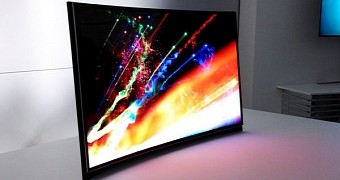You would think that a relatively new display technology that has proven to be superior in terms of image brightness and clarity to LCD would experience considerable momentum, but that's not what's happening.
You might be familiar with OLED. Organic Light Emitting Diode screens have better image quality than liquid crystal displays.
They also have no need of backlighting and can be fashioned into monitors and television sets that are much, much thinner than LCDs. A few mm thin, in fact.
Both Samsung and LG have been eagerly trying and failing to one-up the other at the technology trade shows that took place this year and the last.
And yet now we learn that Samsung has decided not to release any new OLED TVs next year, curved or otherwise. That's right, 2015 will pass without the launch of any new ones.
Samsung announced its postponing of OLED all around the world
Samsung TV head Kim Hyun-seok revealed this to members of the media from the corporation's home country, South Korea, not long ago. Since then, other executives have corroborated those statements.
Sounds strange, considering that the company truly is the major leader of this TV sector alongside LG, however antagonistic the relationship between the two is.
Nevertheless, provided reports aren't full of hot air (and considering the source, that's unlikely), Samsung has truly changed focus. Which brings us to the new Samsung rising star, so to speak.
Quantum dot LCDs are getting attention now
Quantum dot LCD technology allows for very precise color tuning and calibration during the screen's manufacturing process. This leads to better rendering of color.
In other words, Samsung might expect quantum dot LCDs to reach an image quality comparable to OLED tech as it is now, but without the huge price difference versus conventional screens.
Essentially, Samsung is putting OLED on the back burner until further notice, probably 2016 or 2017. By that time, they might finally have advanced enough to no longer be several times more expensive than LCDs of the same size.
It's kind of like solid state drives had to drag along for a few years before they finally manages to strike a good enough price-capacity balance before they could even dream of challenging hard disk drives. And even now they've only secured some specialized parts of the market segment.
With OLED tech still pretty hard to produce in large sizes (at least beyond 40- and 50- inches), that's another reason to further refine the specification before pushing forward.

 14 DAY TRIAL //
14 DAY TRIAL //